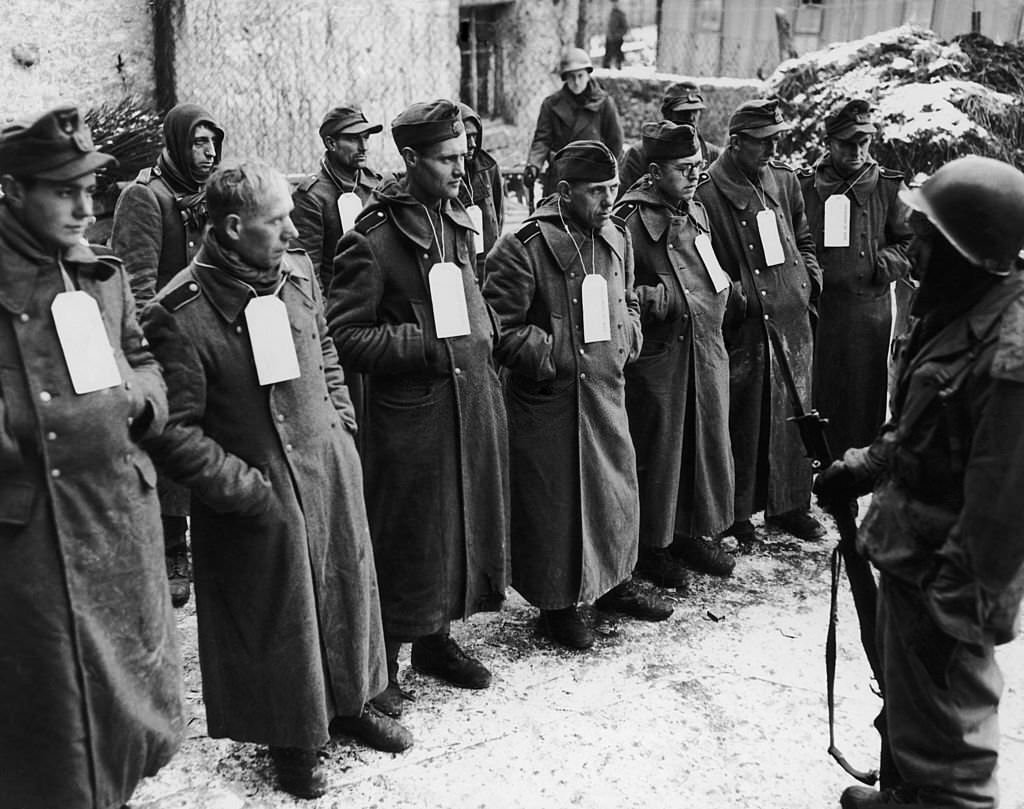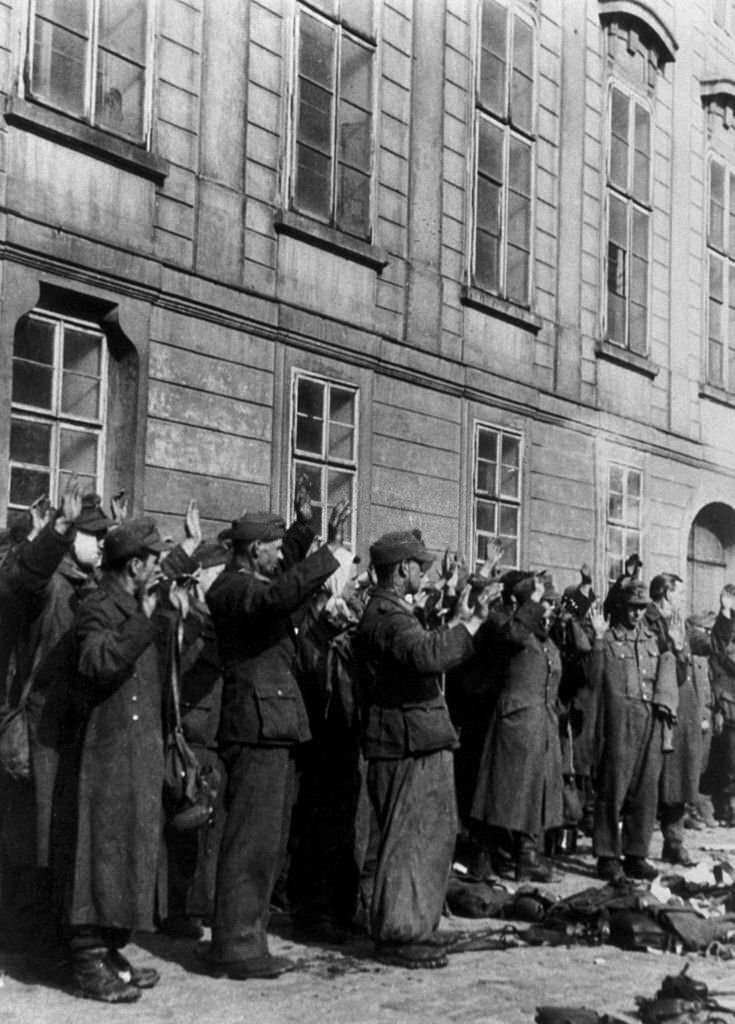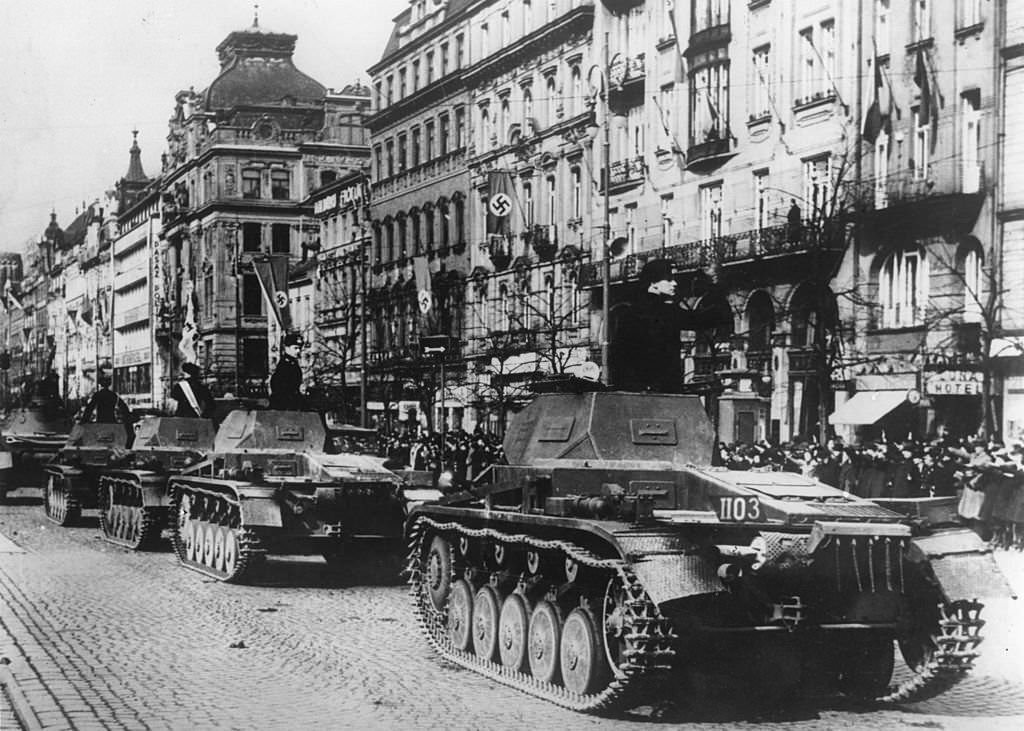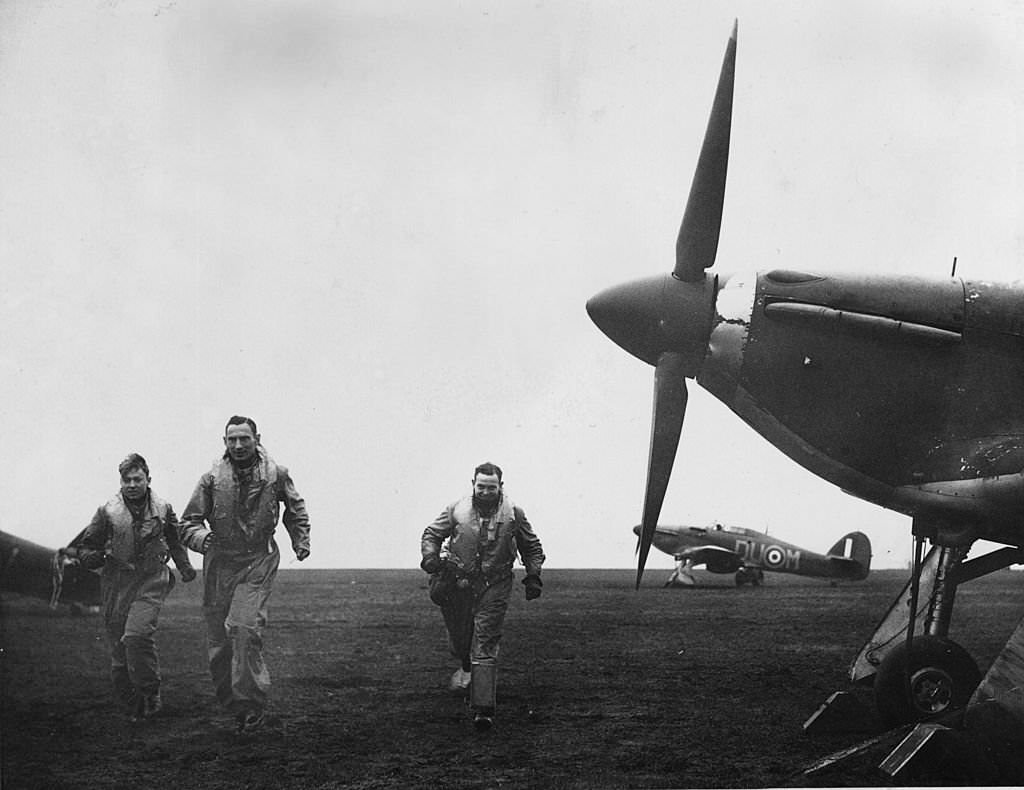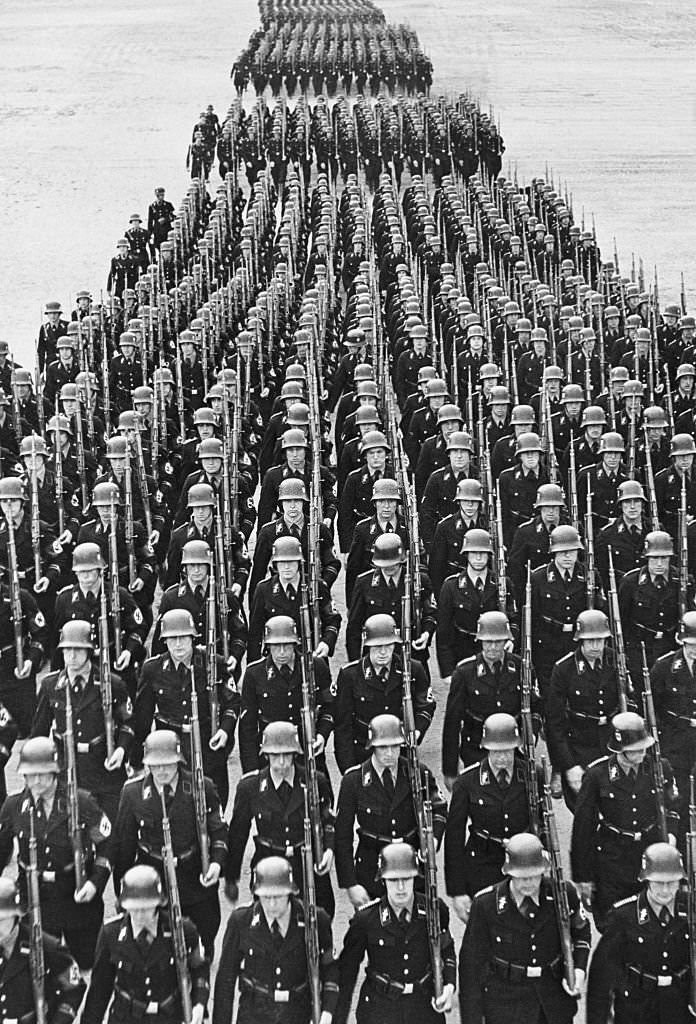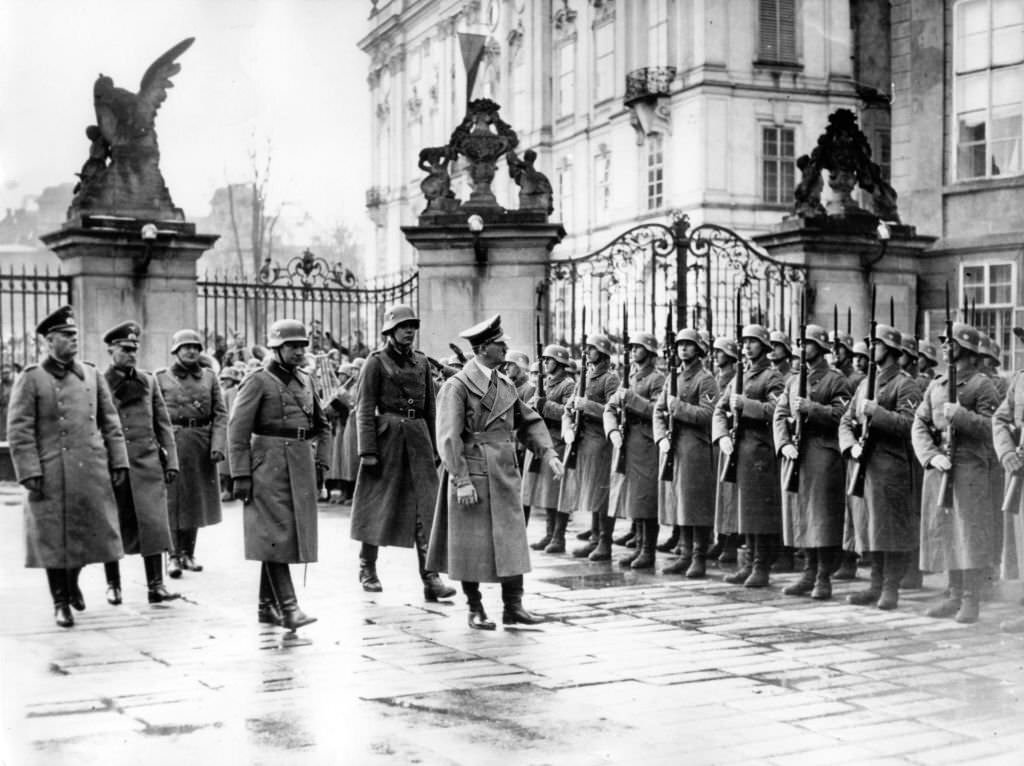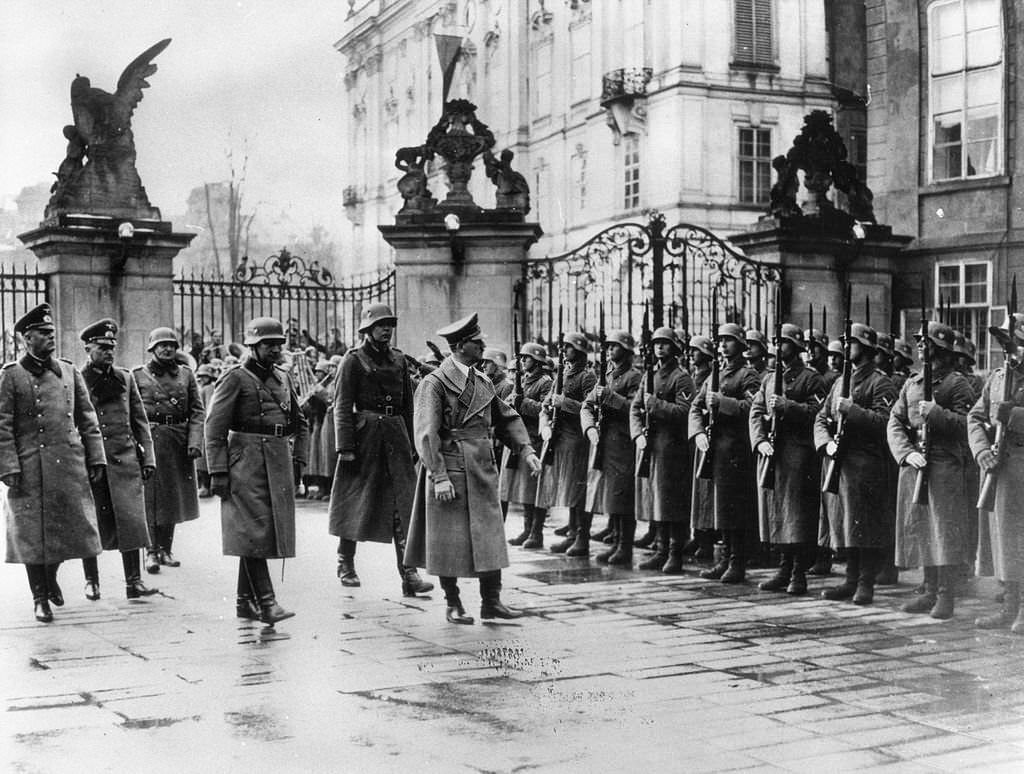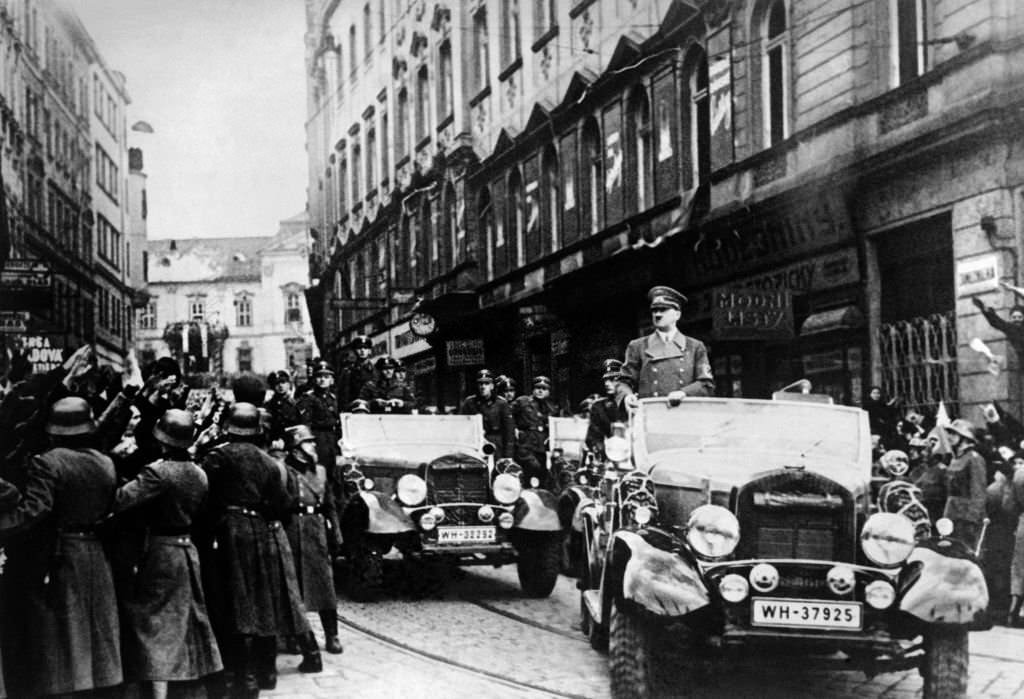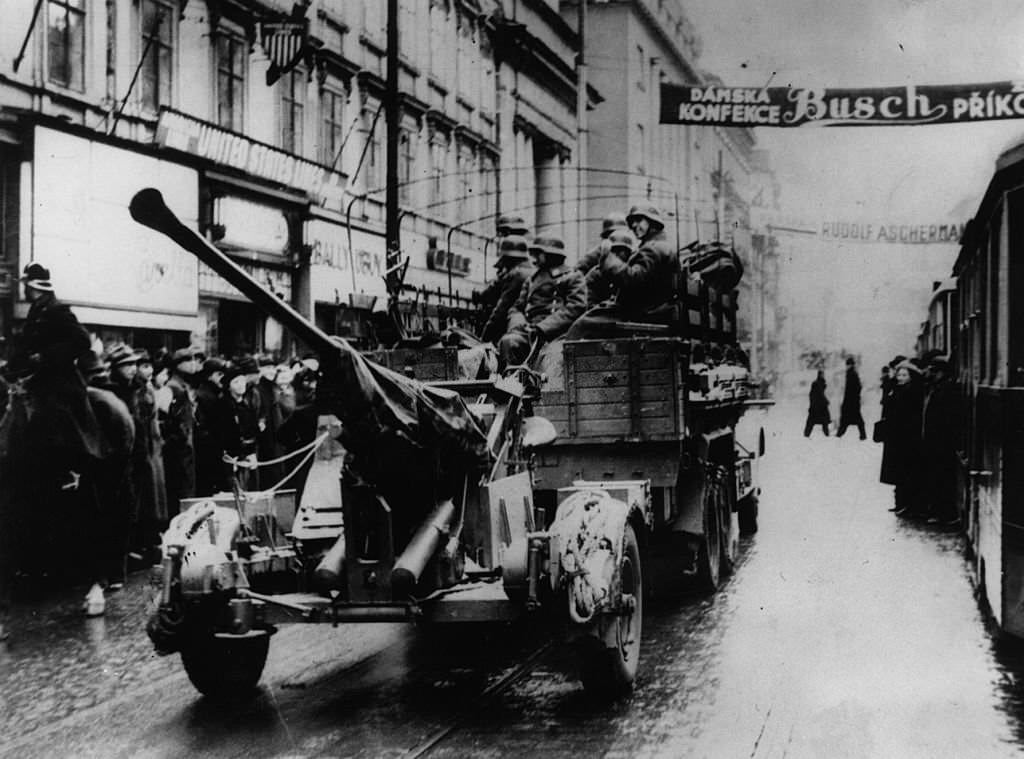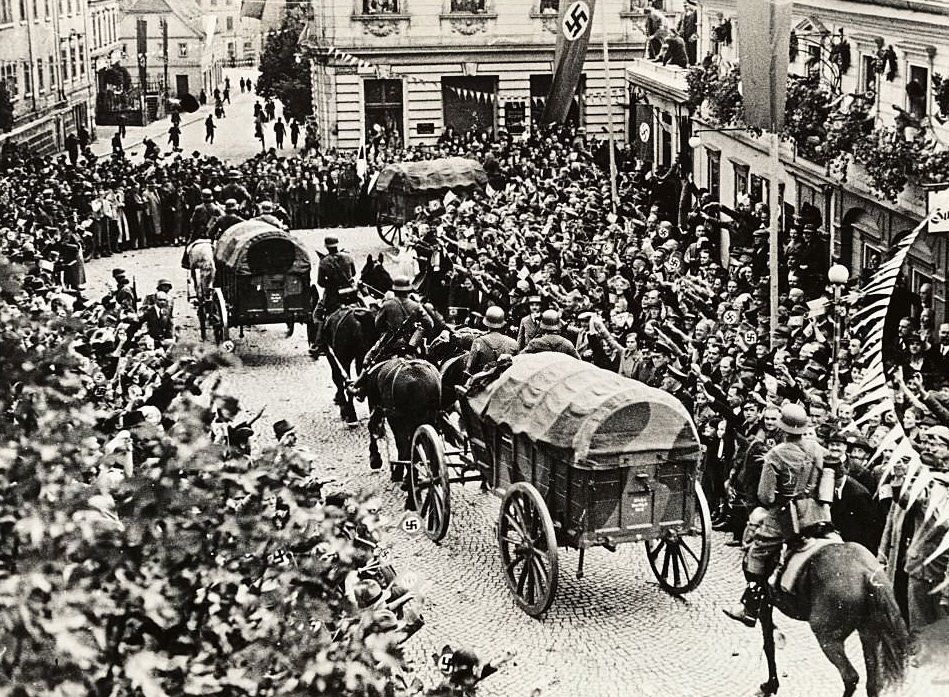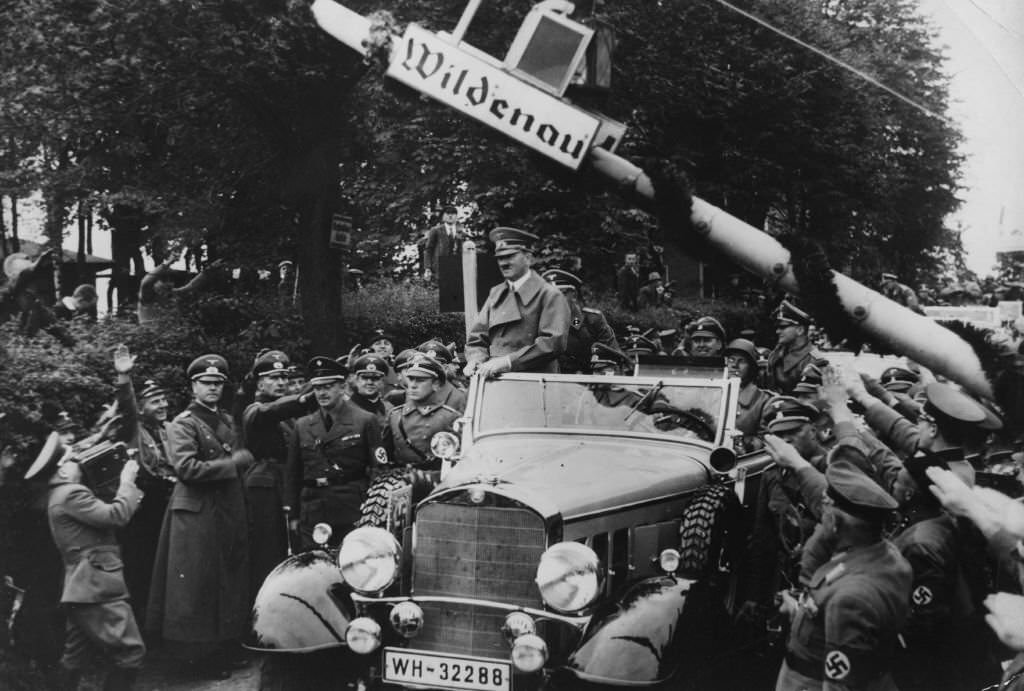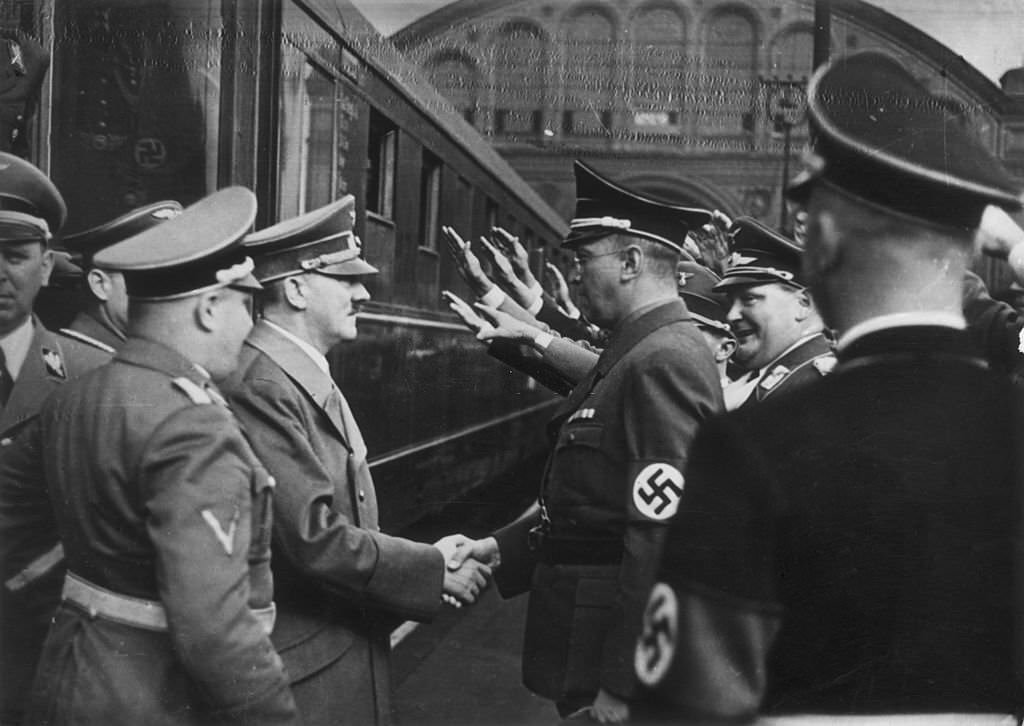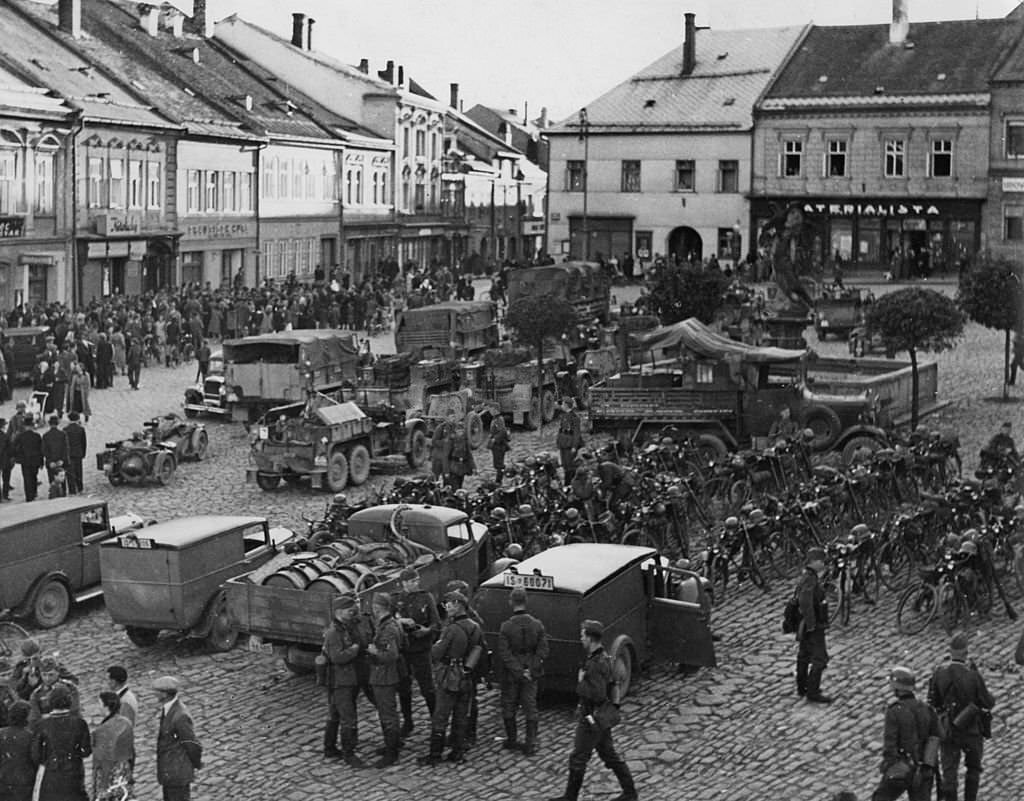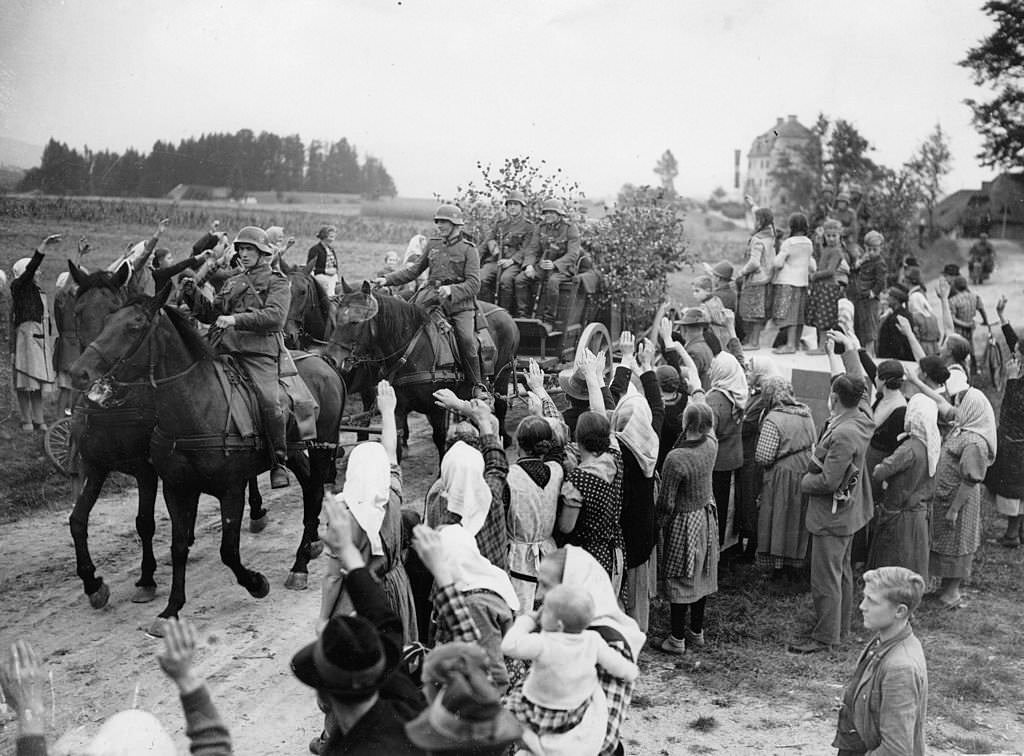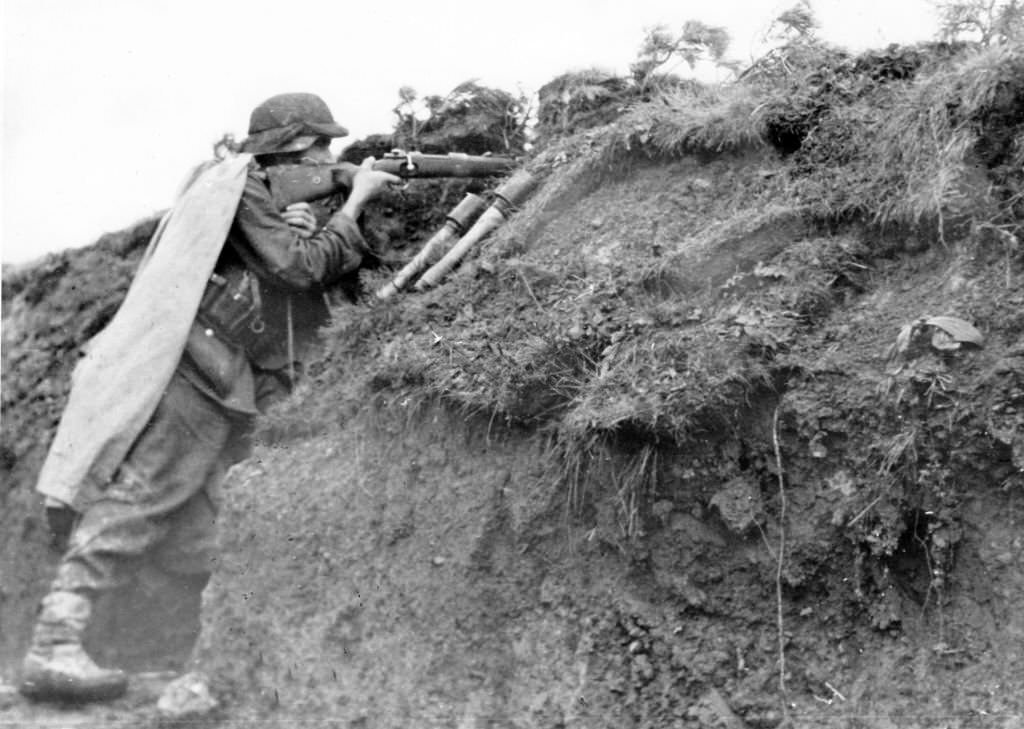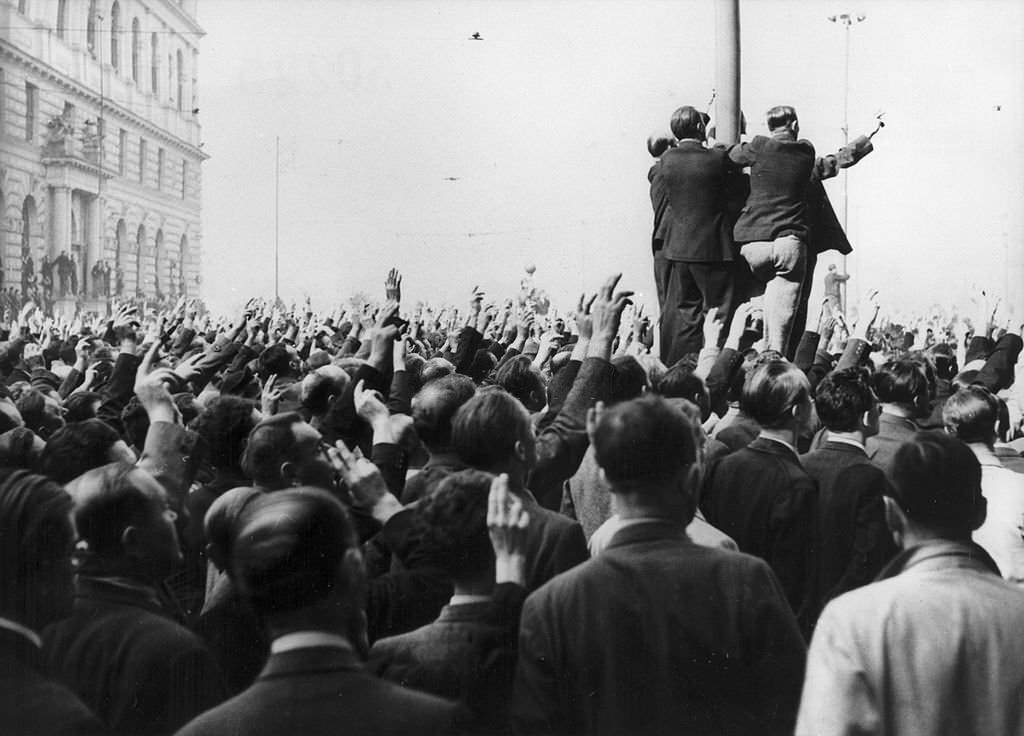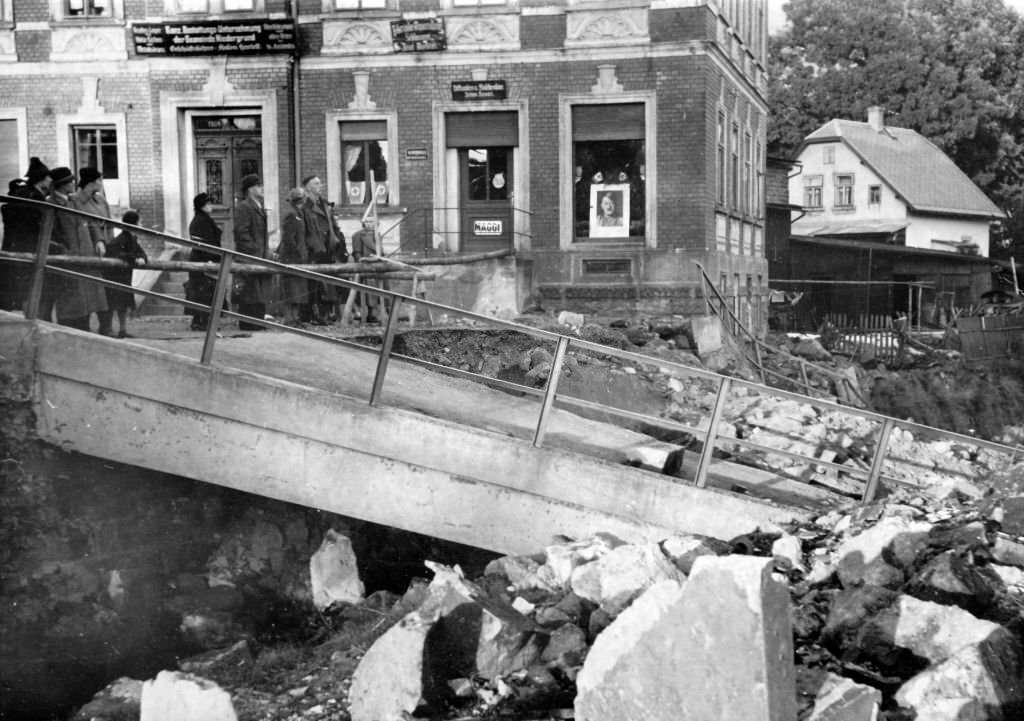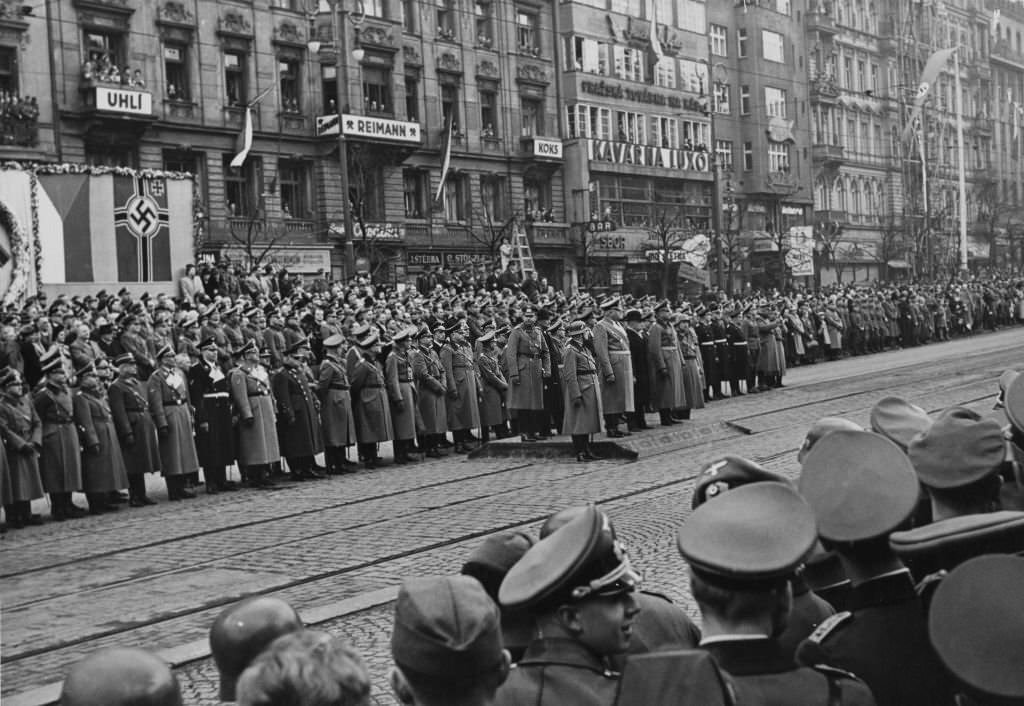British Prime Minister Neville Chamberlain traveled twice to the continent in the aftermath of Germany’s annexation of Austria in 1938 to appease Germany’s aggressive intentions and prevent another destructive European war, but his efforts were unsuccessful. The Soviet Union had promised to intervene, but only if France acted first. Czechoslovakia remained exposed and vulnerable despite negotiating treaties with France in 1926 and the Soviet Union in 1935 to protect itself against German aggression.
The Little Entente of Czechoslovakia, Romania, and Yugoslavia did not use their contemporaneous agreements to defend themselves against any aggression by Hungary. Czechoslovakian Germans resisted Prague rule, led by Konrad Henlein, who had the full support of the National Socialists in Berlin and called for Sudetenland to be unified with Germany. Two months after Hitler annexed Austria, German troops prepared to cross the border in May 1938, and the situation became increasingly tense. President Edvard Beneš was approached by the ambassadors of France and Great Britain on September 19, asking for the handover of the Sudetenland to Germany. The note demanded that the Czechoslovak Republic hand over its Sudeten territories to Germany to prevent an immediate Wehrmacht occupation. Czechoslovakia mobilized its army and air force once more on September 23 in a desperate gesture. Benito Mussolini, Hitler’s ally, then proposed a four-power meeting to resolve the Czechoslovak crisis.
German, British, French, and Italian representatives attended the 1938 Munich conference, but the Czechoslovak delegation was absent. The agreement signed by Chamberlain, Daladier, Hitler, and Mussolini conceded to all of Germany’s demands. Upon uniting the Sudetenland with Germany on October 1, the Czechoslovak Republic lost a significant part of its historical territory, its principal fortifications against Germany, and its iron, steel, and textile factories. Further, with the loss of the Sudetenland came the threat of further losses of border territories in the east that Poland and Hungary coveted. On September 30, Czechoslovakia capitulated a week after mobilizing.
Following the incorporation of the Sudetenland into Germany on October 1, 1938, the rest of Czechoslovakia was left weak. Moreover, a small area of the borderland region known as Zaolzie was occupied by Poland and annexed due to previous territorial claims (Czech-Polish disputes in the years 1918–20). Furthermore, Hungary obtained the southern territories of Slovakia and Carpathian Ruthenia, which were primarily inhabited by Hungarians, as part of the First Vienna Award. On the same day that the Slovak State was declared, Hungary occupied and annexed the remainder of Carpathian Ruthenia. The Czech Prime Minister asked the German Wehrmacht to defend the remainder of the Czech lands after he feared a Hungarian invasion. German troops entered the remaining Czechoslovak territories on March 15, meeting practically no resistance (the only organized resistance was in Mistek, where an infantry company commanded by Karel Pavlík fought the invading Germans).
Hungary’s invasion of Carpatho-Ukraine met resistance, but the army quickly crushed it. Hitler went to Czech lands on March 16 and proclaimed Bohemia and Moravia a German protectorate from Prague Castle. Unlike Hitler’s previous actions, the annexation of the rest of Czechoslovakia was not described in Mein Kampf, despite violating his promises at Munich. Germany had now conquered seven million Czechs despite repeatedly asserting his interest in pan-Germanism, the unification of ethnic Germans into one Reich. Hitler claimed in his declaration that “Bohemia and Moravia have been the Lebensraum of the German people for thousands of years.” After the invasion, British public opinion changed drastically. Chamberlain understood that Hitler had no intention of keeping the Munich Agreement. Chamberlain said that Hitler was trying “to dominate the world by force” during a speech in Birmingham on March 17.
By 1939, Germany’s military production had shifted to Czechoslovakia, producing aircraft, tanks, artillery, and other armaments. Germany occupied Hungary in March 1944 during Operation Margarethe, and Slovakia suffered a similar fate in August 1944 with the Slovak National Uprising. Following World War II, Germany surrendered, ending the occupation. In the period of German occupation, between 294,000 and 320,000 citizens (including Jews, who constituted most of the casualties) were murdered.
#1 The German occupation of Bohemia and Moravia. The German army marching into Prague Castle on March 15, 1939.
#2 Hungarian troops on the march during the occupation of Zone A, consisting of parts of the Csallokez, ceded to Hungary by Czechoslovakia.
#3 Hungarian troops on the march during the occupation of Zone A, consisting of parts of the Csallokez, ceded to Hungary by Czechoslovakia.
#4 The Seamstresses Celebrate The Agreements Of Munich 1938
#5 Refugee Families Of The Sudetes At Masaryk Stadium Near Prague in 1938
#6 Neville Chamberlain Addressing Crowd at Airfield

On his arrival back in England on September 15, 1938, following the signing of the Munich Pact, British Prime Minister Neville Chamberlain speaks to the assembled crowd at the airfield. He declared that the agreement with Hitler and the other Axis leaders would ensure "peace in our time." The Pact surrendered the Sudetenland of Czechoslovakia to Nazi Germany, and was signed by the British and French in the vain hope of appeasing Hitler's appetite for conquest. World War II began just one year later with the German invasion of Poland.
#7 A Czechoslovakian troops in full war equipment ready and prepared to march from a garrison near Prague.
#8 Czech refugees from the german settelment area in the bohemian countries, so called Sudetenland after the invasion of the German armed forces, 1938
#9 German troops enter Hradschin Castle in Prague during their invasion of Czechoslovakia prior to WW II.
#10 Czechoslovakian civilians leaving the Sudetenland under threat of invasion by German troops, September 1938
#11 German deputy mayor of Prague Josef Pfitzner is hanged on a public place after being convicted for taking part in Nazi organisations on September 6, 1945
#12 Czech General Ludvik Svoboda decorates members of the Revolutionary Factory Committees, who took over the running of facilities after the Germans were defeated, 1945.
#13 Captured German troops, including members of the SS and Luftwaffe, and volunteers from Poland and Czechoslovakia, during World War II, 1st June 1945.
#14 View of German troops exiting Prague in trucks after their surrender, Czechoslovakia, World War II.
#15 Cease-Fire On The Western Front 1945.
#16 Remnants of the German Army in Prague surrendering to the Allies.
#17 The liberation of Prague, May 1945. Soviet troops being greeted by citizens of Prague.
#18 Soldiers play an accordion in celebration of the defeat of Germany as refugees file by at the end of World War II in Czechoslovakia.
#19 The German propaganda picture shows military engineers of the German Wehrmacht in the Carpathian Mountains on the Eastern Front.
#20 German soldiers pose in front of the burnt out shell of a farmhouse in Lidice.
#21 German soldiers and army vehicles on the streets of Prague, Adolf’s Hitler’s Germany invaded Czechoslovakia in March 1939
#22 A parade of German PzKpfw II light tanks in Wenceslas Square, Prague, Czechoslovakia.
#23 Czechoslovakian pilots running to their Hurricane fighter planes on an airfield ‘somewhere’ in the north of England after receiving an alert.
#24 German population in front of the windows of the editorial office of german Newspapers in occupied Slowakia, Bratislava, 1940
#25 German Troops in Prague On 1939
#26 German Occupation of Czechoslovakia in Prague on March 16Th 1939
#27 Franz Karmasin (Volksgruppenfuehrer) in Gross-Lomnitz, A lokal leader of the german party (deutsche Partei) gives report, 1940
#28 The German army motorized in Prague.
#29 Hitler’s Elite Guard marches through Prague to enforce martial law after three Czech rebels were executed
#30 The German Wehrmacht parade through Wenceslas Square (Wenzelsplatz) in Prague, during the German occupation of Czechoslovakia, 18th March 1939.
#31 Third Reich – Hitler in Prague 1939.
#32 Crowds watching as German troops enter Brno in Moravia.
#33 The German occupation of Bohemia and Moravia on March 15, 1939. Adolf Hitler reviewing his troops in the 1st courtyard of Prague Castle
#34 Adolf Hitler and his army parade in Prague on March 15, 1939 day of the invasion of Czechoslovakia by the Wehrmacht.
#35 Events leading up to the German occupation of Bohemia and Moravia on March 15, 1939
#36 The German occupation of Bohemia and Moravia.
#37 The German occupation of Czechoslovakia in 1939.
#38 The German occupation of Bohemia and Moravia on March 15, 1939. German troops invading the territory of the Czecoslovak Republic.
#39 Events leading up to the German occupation of Bohemia and Moravia on March 15, 1939.
#40 Events leading up to the German occupation of Bohemia and Moravia on March 15, 1939.
#41 The German occupation of Bohemia and Moravia. The German army marching into Prague Castle on March 15, 1939
#42 The German occupation of Bohemia and Moravia.
#43 The German occupation of Bohemia and Moravia on March 15, 1939.
#44 The day of the consummation of the Munich betrayal. The remaining territory of Czechoslovakia was invaded by the Germn army and the so-called Protectorate of Bohemia and Moravia was declared.
#45 Adolf Hitler and his army parade in Prague on March 15, 1939 day of the invasion of Czechoslovakia by the Wehrmacht.
#46 Crowds on the sidewalk salute Nazi soldiers riding in a motorcycle infantry unit as German troops enter Prague, Czechoslovakia.
#47 German troops riding on horseback during a parade through Prague shortly after the German takeover of Czechoslovakia and the creation of the Protectorate of Bohemia and Moravia, World War II.
#48 Czech soldiers attempt to protect their borders from imminent German attack during World War Two, March 14th 1939.
#49 German troops entering Prague by lorry, towing anti-aircraft guns.
#50 The German Army enters Prague with a procession of motorcycles in March 1939, several months prior to the commencement of the European War.
#51 The Occupation of Czechoslovakia, Czech mounted police watching a German truck pass through the streets of Prague
#52 March 1939 German army enters Prague after the annexation of Czechoslovakia.
#53 German troops enter Prague in Czechoslovakia, at the beginning of the German occupation, 1939. On the right is a Czech police officer.
#54 German Troops Parade in Streets of Czechoslovakian Town, 1939
#55 Assembled crowds greet the entry of German troops into the Warnadorf district, one of the areas invaded by Czechoslovakia.
#56 A woman in the Sudetenland greets incoming German troops with tears and a German Salute.
#57 A Czech woman pressed into service making bricks after the German occupation of her country, Adolf’s Hitler’s Germany invaded Czechoslovakia in March 1939
#58 The Hlinka Guards displaying German armbands near the Town Hall.
#59 Visit of the president Tuka (prime minister of Slovakia) in Berlin (in the center, Ribbentrop).
#60 German soldiers on motorbikes during the invasion of Prague, Czechoslovakia.
#61 Food queues in German-occupied Prague, Czechoslovakia.
#62 Three German soldiers sit behind an anti-aircraft machine in a camouflaged post overlooking the Sudetenland countryside, Czechoslovakia, World War II.
#63 Steel helmeted German troops marching into Prague during the invasion of Czechoslovakia. By-standers are giving them a German salute.
#64 Three German 5.4 GOK bombers fly over Sudetenland after Germany took control of the region with the signing of the Munich Pact, Czechoslovakia.
#65 The German propaganda picture shows German troops marching into Reichenberg, Sudetenland (today Liberec, Czech Republic) in October 1938.
#66 Adolf Hitler is welcomed by crowds lining the streets of Carlsbad (now Karlovy Vary) in the Sudetenland, Czechoslovakia, after the annexation of the territory into the German Reich, 6th October 1938.
#67 The Germn propaganda picture shows destruction after the German occupation of the Sudetenland in October 1938.

A large portrait of Hitler decorates a shop window next to a swastika flag. The Germn news service writes on the back of the picture: "After the withdrawal of the Czechs. The Czechs detonated the bridge between Niedergrund and Kreibitz before the arrival of German Division II on Sunday, 01 October. Several buildings were also destroyed and five people were killed.
#68 Adolf Hitler stands up in his car to acknowledge his welcome as he crosses the frontier into Sudetenland.
#69 Ethnic Germans living in the Sudetenland in Czechoslovakia welcome the German troops who have arrived to annex the region under the terms of the Munich Pact.
#70 Adolf Hitler crosses the Wildenau border from Germany into Sudetenland with his troops at the start of World War II. Sudetenland or Sudety, formerly a frontier region of the Czech Republic was ceded to Germany in the Munich Pact, but restored after the war. (Photo by Keystone/Getty Images)
#71 Troops of the German army march into Czechoslovakian territory and parade in the town square at Rumberg, which has been decorated with swastika banners.
#72 German troops enter Czechoslovakia.
#73 German armoured vehicles pass through a customs barrier between Germany and Czechoslovakia.
#74 German troops entering Waldhaeusl in Czechoslovakia.
#75 Troops of the German ‘defence force’ (Wehrmacht) are welcomed as they march across the border at Wald Haenst into Czechoslovakia.
#76 German troops enter Schonlinde (Krasna Lipa) in the Sudetenland, as Germany annexes the region, 2nd October 1938.
#77 Ethnic Germans salute a message of liberation from German commander Wilhelm Ritter von Leeb after the German annexation of the Sudetenland, 2nd October 1938.
#78 After signing the Munich Pact, German chancellor, Adolf Hitler (1889 – 1945) returns to Berlin in triumph and is greeted by Konrad Henlein (right), leader of the Sudeten German Party.
#79 German soldiers making their way through a street in the Sudetenland part of Czechoslavkia during the invasion and occupation of the country prior to World War Two
#80 German troops enter Policka (Politschka) in the Sudetenland (now in the Czech Republic), as Germany annexes the region, former Czechoslovakia, October 1938.
#81 A German marching band crosses the border near Haidmuhle in Bavaria to enter the Sudetenland, as Germany begins its annexation of the region, 1st October 1938.
#82 Women and young boys celebrating the German occupation of Asch, home of Konrad Henlein, leader of the Sudeten German party.
#83 Peasants give German soldiers the Hitler salute as they cross the Czechoslovakian border
#84 French Head of Government Edouard Daladier is signing the Munich Treaty as Hitler’s Secretary Martin Bormann (2nd R) and Germn Foreign Minister Joachim von Ribbentrop (R) look on on September 29, 1938 in Munich.
#85 These Sudeten German civilians who fled into Germany during the Czech-German crisis might be called the Vanguard of the German army of occupation.
#86 British Prime Minister Neville Chamberlain passes a Germn honour guard on his arrival at Oberwiesenfeld airport before a meeting with Adolf Hitler over the latter’s threats to invade Czechoslovakia, 29th September 1938.
#87 Chamberlain Arrives In Munich

British Prime Minister Neville Chamberlain (1869 - 1940, third from left) passes a Nazi honour guard on his arrival at Oberwiesenfeld airport before a meeting with Adolf Hitler over the latter’s threats to invade Czechoslovakia, 29th September 1938. Left to right: Reichsstatthalter of Bavaria, Franz Ritter von Epp (1868 - 1947), British Ambassador to Germany Sir Neville Henderson (1882 - 1942), Chamberlain, and German Foreign Minister Joachim von Ribbentrop (1893 - 1946).
#88 Labour politician Ellen Wilkinson making a speech at a ‘Save Peace’ demonstration in Trafalgar Square, London, on the Czech-German crisis, 18th September 1938.
#89 Czech soldiers digging trenches in the face of imminent German attack, The Sudetenland, the Czechoslovakia border regions, were ceded to Germany after the Munich agreement of 1938,
#90 A delegation of British Communist members of Parliament called on Prime Minister Chamberlain and demanded that a special session be convened where the question of Britain’s position towards Czechoslovakia would be debated
#91 A Sudeten German hospital in Czech Elbogen (Looket) in May 1938.
#92 Czechoslovakian Army at Attention.
#93 German soldiers on their arrival in Waldhaeusl in the so-called Sudetenland, 1938
#94 Members of the German Labor Corps stand along a street curb holding shovels as a young girl welcomes them to Sudetenland with flowers.
#95 German invasion of Prague 15 March 1939.
#96 German Soldier Saluting at Ceremony.
#97 German occupation of the Sudetenland.
#98 The arrival of President E. Benes and members of the Czechoslovakian government in Czechoslovakia.
#99 The German Wehrmacht in the Carpathian Mountains on the Eastern Front.
#100 The invasion and occupation of Czechoslovakia, 1939.
#101 The invasion and occupation of Czechoslovakia, March 1939,
#102 A Detachment of Motorcycle Troops
#103 The German army marching into Prague Castle on March 15, 1939.
#104 The Occupation of Czechoslovakia, Czech mounted police watching a German truck pass through the streets of Prague
#105 German machine gunners muffled to the ears against the severe cold stand ready for action in a Prague street.
#106 Germany Invades Czechoslovakia

War and Conflict, The invasion and occupation of Czechoslovakia, 1939, German soldiers on the streets of Prague, Adolf's Hitler's Germany invaded Czechoslovakia in March 1939 after a list of demands and ultimatums from the Nazis were not met (Photo by Popperfoto via Getty Images/Getty Images)













